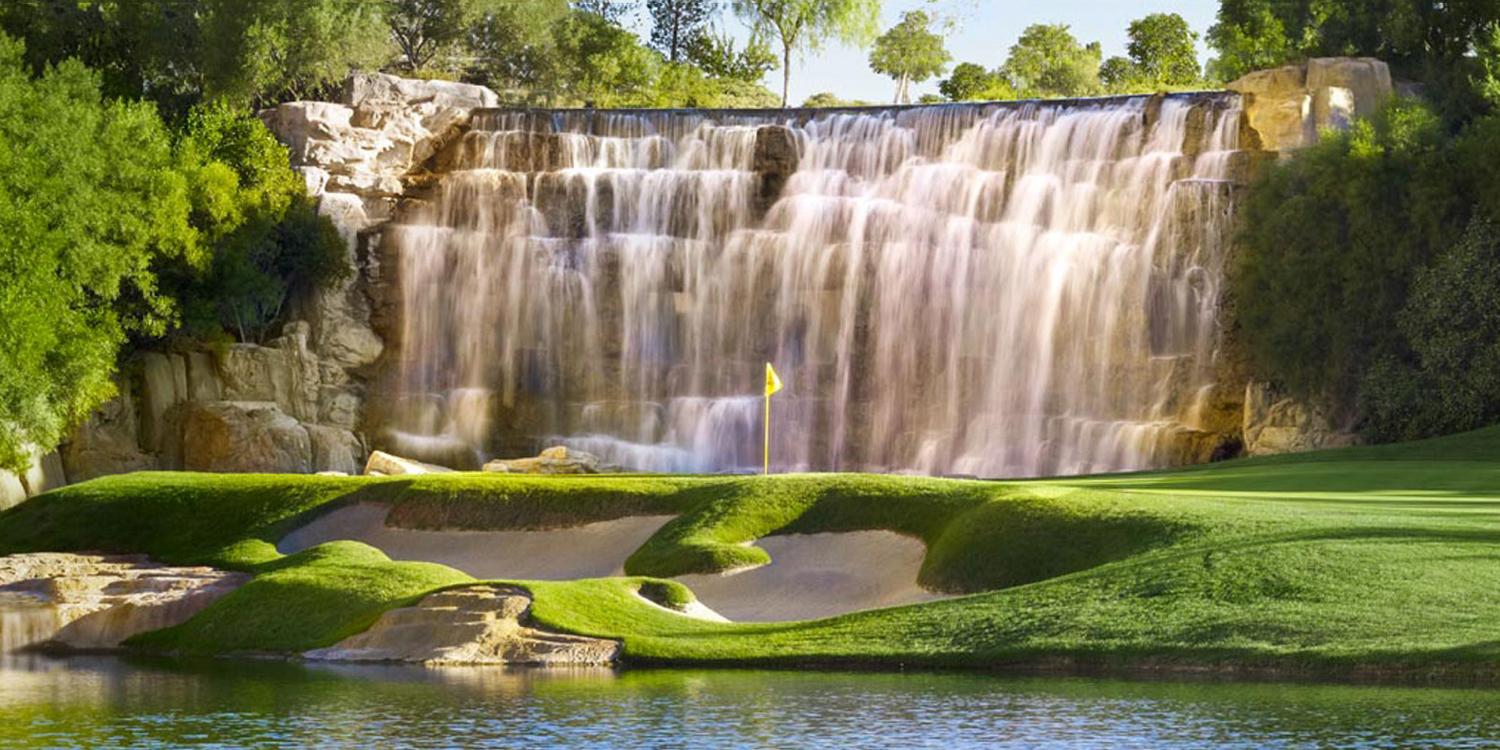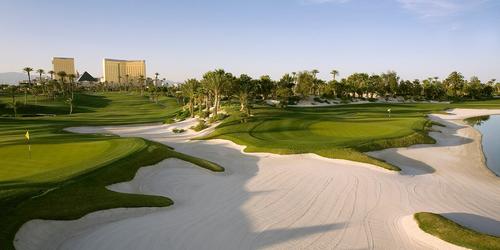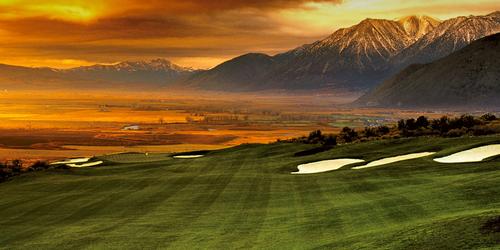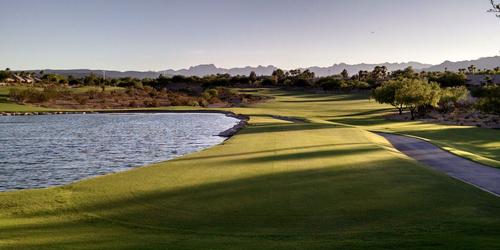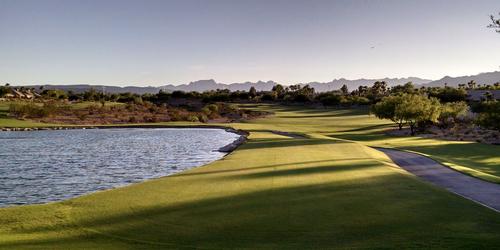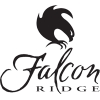Wynn Golf Club Reopens in Las Vegas
Hole By Hole Desciption of the New Course
By Brian Weis
The only resort golf course on the Las Vegas Strip returns to Wynn Las Vegas on Friday, October 11, with the grand reopening of the Wynn Golf Club. The original 18-holechampionship course established in2005 has been reimagined by legendary golf course architect Tom Fazioto give players a new golf experience from the first drive to the last putt.
Below is a hole by hole description:
Hole 1 Par 4, 431 Yards
The dramatic elevated tee shot introduces golfers to elevation changes that are indicative of the entire golf course. This strong dogleg right hole is bunkered on the right side, tempting players to challenge the inside angle of the fairway for a shorter approach shot. However, placing the tee shot to the left side of the fairway is safer and allows for the best angle into the left to right green. A generous fairway approach feeds into the left side of the green.
Hole 2 Par 3, 192 Yards
The first of six dramatic par 3's on the course, this hole features an elevated green and requires a well struck right to left tee shot. The receptive green has a backstop contour in the last 15 ft. of the green. When making a club selection, hitting a little long versus a little short is important to avoid the deep bunker that guards the left side of the green. There is room to miss the green to the right.
Hole 3 Par 5, 515 Yards
The first par 5 on the course reachable with two well hit shots starts from a narrow vegetated tee chute. The fairway landing area is flanked with two bunkers on the left side. A tee shot favoring these bunkers provides the optimum angle to reach the green in two shots, which is bordered by a stream feature on the right side that extends into the second landing area. Deciding to go for the green in two shots or to lay-up is a tough decision because the stream feature challenges a lay-up in front of the green. The safest lay-up zone with the most width is from 100 yards out.
Hole 4 Par 4, 420 Yards
This hole is lengthened with new tees added. If the golfer can favor the left side of the landing area with a tee shot, it allows for a better angle into the green on the approach. The left side of the fairway also allows for ground play into the green. The green will persuade the ball to a back right pin location
Hole 5 Par 3, 147 Yards
This short downhill Par 3 requires an accurate short iron to avoid the pond along the left side. The long green has a strong slope on the right side that feeds the ball to the left. A back pin location takes both distance and spin control to have a short birdie putt. Contour across the green prior to the back pin creates this tough birdie pin.
Hole 6 Par 4, 375 Yards
This is a dogleg right with the fairway sitting in a valley. Avoid the right hillside bunker as it creates problems getting to the green from this hillside positon. The elevated green makes distance control on the approach key and helps defend the hole. Golfers can send their approach shot into the receptive left side approach. Par is a great score when the pin is located on the back right.
Hole 7 Par 3, 157 Yards
This par 3 requires a solid carry over the water the entire distance to the green. Golfers cannot be short, and birdie seekers need to be aware of the left greenside bunker as it will short side them on the green and make for a tough up and down.
Hole 8 Par 5, 536 Yards
A medium-length par 5 with an elevated tee, the wide and receptive fairway spreads out before the golfer. This dogleg left promotes playing down the right side of the fairway for the best angles of attack. The second shot lay-up area and the green are heavily bunkered, so accuracy is important when choosing shots into the green.
Hole 9 Par 4, 464 Yards
This long-distance par 4 requires a long and accurate tee shot for a scoring opportunity. Favor the right side of the fairway off the tee to give the best approach angle into the green, which sits almost straight from back to front with a generous approach feeding in from the right side. If hitting a long iron or hybrid, the approach allows players to run the ball into the green and avoid the bunker on the left.
Hole 10 Par 3, 233 Yards
The second longest par 3 on the golf course requires a solid long iron or hybrid to reach the green. The contours of the green and placement of a left greenside bunker provide for a subtle defense for this green complex. A back right pin placement makes the approach shot for birdie opportunities more challenging. Playing short of this green and getting up and down for par is a good play.
Hole 11 Par 5, 591 Yards
The longest par 5 on the golf course is a true 3-shot hole. Hitting from the framed tees toward the left side fairway bunkers allows for the best approach angle into the green; but it's a long way home.
Hole 12 Par 3, 209 Yards
A dramatic downhill par 3 with water protecting the left side of the green requires aiming to the front right corner of the green and letting the ball feed into the middle. If the green is missed players will have a manageable chip out of the expanded approach area. A savoir bunker is positioned back left to catch errant shots that are hit a little too strong.
Hole 13 Par 5, 520 Yards
This par 5 is straightforward from the tee box. Favor the left side if trying to reach the green in two shots. Otherwise, be strategic with an approach lay-up shot because the second landing area is protected by a stream crossing and a left side fairway bunker. A deep bunker protects the green on the right side.
Hole 14 Par 4, 442 Yards
This hole plays from an elevated tee complex that gives golfers a good sense of perspective. Challenge the right side fairway bunker to have the best angle of attack into the right to left green, which is hidden and protected by trees on the left. If a player gets blocked out by the trees on the left, use the front portion of green or approach as a safe place to play as the contours will feed the ball to the left. The fairway approach has been expanded to wrap around the right side and back of the green.
Hole 15 Par 4, 360 Yards
From a framed tee shot within the trees to the narrow fairway, this par 4 requires accuracy off the tee. A large bunker on the left side of the fairway warns golfers away from the left and out of bounds. Playing short of this bunker on the tee shot is the safest route off the tee. A precise approach shot is required on this contoured green which is protected with bunkers on both the right and left.
Hole 16 Par 4, 486 Yards
The longest par 4 on the golf course requires two solid shots. On the tee shot take aim at the left side fairway bunker in the distance to set up the best angle on the approach shot. The left side of the green has a generous approach to allow for running the ball into the green with long irons and fairway metal.
Hole 17 Par 4, 395 Yards
This new dogleg right par 4 is framed with a large lagoon along the right side of the green. A tee shot hit to the left side of the fairway puts golfers in the best position to attack the green on the second shot, as the green sits left to right and is protected with a bunker on the left and the lagoon on the right. The shape of the green will assist balls feeding into the green toward the lake from the left side as well.
Hole 18 Par 3, 249 Yards
This long and strong par 3 provides a visually stunning finish to the round with an epic waterfall in the background. It requires a long precise tee shot to avoid the lagoon on the left side off the green. Favoring the front right side of the green provides for the best angle to attack. To reach it safely, one must choose a good line and control distance. The green sits slightly above the fairway and is angled right to left, sloping toward the water.
Revised: 10/22/2019 - Article Viewed 19,798 Times
- View Course Profile
About: Brian Weis
![]() Brian Weis is the mastermind behind GolfTrips.com, a vast network of golf travel and directory sites covering everything from the rolling fairways of Wisconsin to the sunbaked desert layouts of Arizona. If there’s a golf destination worth visiting, chances are, Brian has written about it, played it, or at the very least, found a way to justify a "business trip" there.
Brian Weis is the mastermind behind GolfTrips.com, a vast network of golf travel and directory sites covering everything from the rolling fairways of Wisconsin to the sunbaked desert layouts of Arizona. If there’s a golf destination worth visiting, chances are, Brian has written about it, played it, or at the very least, found a way to justify a "business trip" there.
As a card-carrying member of the Golf Writers Association of America (GWAA), International Network of Golf (ING), Golf Travel Writers of America (GTWA), International Golf Travel Writers Association (IGTWA), and The Society of Hickory Golfers (SoHG), Brian has the credentials to prove that talking about golf is his full-time job. In 2016, his peers even handed him The Shaheen Cup, a prestigious award in golf travel writing—essentially the Masters green jacket for guys who don’t hit the range but still know where the best 19th holes are.
Brian’s love for golf goes way back. As a kid, he competed in junior and high school golf, only to realize that his dreams of a college golf scholarship had about the same odds as a 30-handicap making a hole-in-one. Instead, he took the more practical route—working on the West Bend Country Club grounds crew to fund his University of Wisconsin education. Little did he know that mowing greens and fixing divots would one day lead to a career writing about the best courses on the planet.
In 2004, Brian turned his golf passion into a business, launching GolfWisconsin.com. Three years later, he expanded his vision, and GolfTrips.com was born—a one-stop shop for golf travel junkies looking for their next tee time. Today, his empire spans all 50 states, and 20+ international destinations.
On the course, Brian is a weekend warrior who oscillates between a 5 and 9 handicap, depending on how much he's been traveling (or how generous he’s feeling with his scorecard). His signature move" A high, soft fade that his playing partners affectionately (or not-so-affectionately) call "The Weis Slice." But when he catches one clean, his 300+ yard drives remind everyone that while he may write about golf for a living, he can still send a ball into the next zip code with the best of them.
Whether he’s hunting down the best public courses, digging up hidden gems, or simply outdriving his buddies, Brian Weis is living proof that golf is more than a game—it’s a way of life.
Contact Brian Weis:
GolfTrips.com - Publisher and Golf Traveler
262-255-7600

